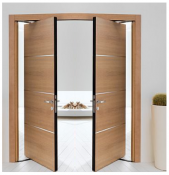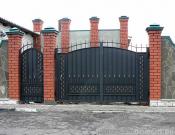Search
Login
Recommended
Why porcelain tiles are gradually replacing ceramic tiles, how to choose porcelain tiles
Over the past decade, granite has been steadily winning the market for building materials for wall and floor cladding. Let's try to figure out what are the advantages of porcelain stoneware over ceramic tiles.
Content
- General information
- Porcelain production technology
- The difference in porcelain composition
- Choose a color depending on the location of the porcelain stoneware
- Advantages of porcelain tile video
- Matte Porcelain Tile
- Polished Porcelain Tiles
- Semi-polished porcelain tile
- Structured Porcelain Tile
- What to look for when buying porcelain stoneware
- Porcelain stoneware specialist tips video
General information
Porcelain tile appeared in the late 80s in Italy.
At the same time, he appeared quite by accident at one Italian factory for the production of ceramic tiles.
A technological failure occurred at this factory, the result of this failure was a new building material that looked similar to gray granite.
At first, this new material was rejected, but by a lucky chance, experts drew attention to its high density, since in density it was close to granite and not to ceramics.
Thus, a unique new material called stone porcelain was introduced to the construction market.

In our country, it is called porcelain tile.
Porcelain production technology
Unlike granite agglomerate, granite does not include granite chips, since porcelain is made from the same materials as high-quality ceramic tiles.
The composition of porcelain stoneware is clay, kaolin, feldspar, quartz sand and mineral pigments.
The whole trick is production technology.

Under a pressure of 400-500 kg per square centimeter, the raw material mass is pressed, then it is fired at a temperature of 1200-1300 * С.
The result is a monolithic stone formation.
The difference in porcelain composition
Porcelain tiles are subdivided into glazed, partially stained and fully colored (homogeneous).
Glazed porcelain tiles cannot be distinguished in appearance from ordinary glazed tiles.
The difference is only in high performance.

Partially stained porcelain stoneware has a two-layer structure, in the first layer of which there is a thick base, and in the second layer it is thinner and pigmented.
Thanks to two layers there is a significant saving of expensive pigments.

The most widespread homogeneous porcelain tile.
The coloring of such porcelain tiles runs along the entire depth of the material.
The result of such coloring is almost eternal material, since even the abrasion of the upper layer does not violate the overall pattern.
Choose a color depending on the location of the porcelain stoneware
The simplest and most economical was the homogeneous porcelain stained with salt and pepper.
The name was due to the outward resemblance to a mixture of salt and pepper.
Porcelain stained monocolor is more expensive, since more expensive pigments are used for painting.
Such porcelain stoneware does not fade even in direct sunlight and can be used not only indoors, but also in the open air (terraces, balconies).

The most expensive porcelain stoneware is porcelain stoneware with a natural stone pattern, since this material is obtained using several expensive pigments, and the process of mixing these pigments is very complicated. The result of such complex work is any noble stone.
It should be noted porcelain tile, which imitates an old piece parquet. Such parquet at a price much cheaper than natural elite, but it will last forever.
Advantages of porcelain tile
Porcelain tile has practically no pores, i.e. it is a very dense, hard, resistant to water and abrasive material.
Water absorption is lower than any natural stone, only 0.05%.
As a result, such material can be used both in humid indoor and outdoor environments.
Porcelain tile has a high resistance to chemicals.
Porcelain tile has high abrasion resistance (8 units), two units higher than natural granite and one unit higher than quartz.
This material has high impact strength, bending strength, resistance to temperature extremes, has a color and pattern depth, retains color under the influence of external factors.
Matte Porcelain Tile
After exiting the kiln, if the porcelain tile does not receive additional processing, an opaque porcelain tile is obtained.

Such material does not have an external gloss, but has a very high hardness and is endowed with the highest performance characteristics.
This material has proven itself in the most severe conditions.
Polished Porcelain Tiles
If you cut off the front surface of matte porcelain stoneware and polish it well, we will get extraordinary beauty with a mirror shine and deep pattern polished porcelain stoneware.
But beauty requires sacrifice, polished porcelain stoneware breaks the structure, and wear resistance decreases.
Such porcelain tiles are best used for wall cladding.

Floors with such porcelain stoneware can be laid only in the living room, for other places polished porcelain stoneware will not work, because when water gets in, the polished surface becomes very slippery, and sand and dirt will quickly spoil the appearance.
Semi-polished porcelain tile
If you partially polish the top layer of matt porcelain stoneware, thereby obtaining a beautiful texture with alternating polished sections with a matte surface - this is semi-polished porcelain stoneware.

Such material is more practical than polished, the structure is not broken, all high performance characteristics are preserved.
Structured Porcelain Tile
The surface of structured porcelain stoneware has a beautiful relief structure.
You can create beautiful panels with geometric patterns, beautiful patterns - it would be only desire and imagination.

Such a porcelain tile is a godsend for a capable designer.
What to look for when buying porcelain stoneware
When choosing porcelain tiles, pay attention to the weight per square meter of the coating.
A square meter of high-quality porcelain tile, with a tile thickness of 8.5 mm, should be at least 18-19 kg. If the weight is less, then the production technology is violated.
Check the tile for density, to do this, look at the back of the tile. High-quality porcelain stoneware on the reverse side has not deep recesses of square shape, the sides of the squares of the recesses should be 1.5-2 cm. If the sizes do not match, the porcelain stoneware is of poor quality.
Please note that after firing, the size of the tile is slightly different from the one stated on the package.
The responsible manufacturer develops a caliber table of ceramic granite tiles, this helps to group the tiles. The tolerance is usually 0.6 mm.
Porcelain stoneware specialist tips
If you want to create a seamless canvas from porcelain stoneware - use edged or rectified porcelain stoneware.
Plates of such porcelain stoneware have exact dimensions, the edges are cut with a diamond tool, thereby the edges have a very smooth surface.

Porcelain tiles must not be placed on a sand-cement mixture or cheap glue, since porcelain stoneware does not absorb cement milk, and the use of such materials as adhesives leads to the formation of voids under the slabs and under load, these slabs crack.





